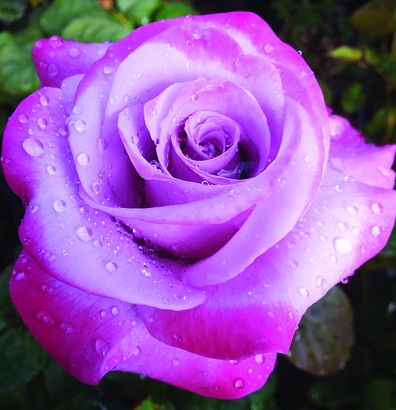Why your roses aren't blooming as well as they should - and how to fix the main problems that arise
By Diana Sargeant|
Here are some of the most common reasons of what goes wrong with roses, and why.
Potted rose not performing after planting in the ground
When you plant a new potted rose in your garden you may expect it to endure some transplanting shock. This can be reduced by soaking the newly planted rose with a liberal dose of seaweed solution at the rate of one 10-litre (21-pint) watering can per bush at planting. Leave it to settle in without any more attention for a couple of days and definitely do not keep watering it.
If, after a week or so, the new rose still looks unhappy or the foliage is drooping and falling off, don't just leave it in the ground to suffer. Dig it up and pop it back into a pot, give it a light trim and soak it again with seaweed solution.
READ MORE: Gardener reveals how he grows plants without digging or tilling the soil?

There is most definitely something wrong in the soil where you planted the rose and you may discover the reason when you dig it up. Here are a few things that might be wrong:
There is rotting compost or fertilizer at the base of the hole 每 the roots are severely compromised and will die so the new rose has no support system.
The hole is lined with clay and water is sitting in the hole like a sump 每 the rose is drowning.
The rose is not getting enough water 每 the soil may be hydrophobic (resisting water) and needs soil-wetter, compost and mulch.
Bare-rooted rose not performing after planting
If you purchased your roses by mail order, open the parcel immediately to check the quality of your new rose plants and get them into a bucket of weak seaweed solution. They can remain soaking for up to 24 hours.
Should it not be possible to plant the roses immediately after soaking, they should be heeled into friable soil in the garden or quality potting mix in a large tub until time permits you to plant them into their allocated space. Soak them after heeling-in to dispel air from drying the roots.
The roots should never dry out.

Most bare-rooted roses hit the ground and start to produce new shoots almost immediately and certainly should have new growth happening within two weeks of planting.
Some roses are a bit slower to get going and take longer to settle in. If they have not produced evidence of new growth after three weeks there is probably an issue with the soil. If you cannot diagnose the problem, take action immediately by digging up the roses and putting them in pots.
Check the following:
If the soil is sopping wet, raise the soil profile and place a slotted drainage pipe to drain water away from the rose bed.
No fertiliser or anaerobic (non-decomposed) compost or other material should be under the roots 每 only seaweed solution should be used when planting new roses.
Severe frost would be indicated by blackened stems 每 replant closer to spring when frosts are over.
Crinkled dehydrated stems indicate the roots were left to dry out either prior to or after planting.
Once any issues with the soil are rectified and you are confident the soil is adequately conditioned for bare-rooted roses to grow happily, replant the roses. Dehydrated roses with crinkled stems should be thrown away because they will never recover.
Sunburn on roses
Roses will not die from the effects of sunburn. However, the lower branches on rose stems are very susceptible to sunburn when there is inadequate foliage to shade those branches and evaporated moisture in the thick stems is not replenished as quickly as in the upper-storey leaves during hot weather.

Sunburn can occur in early spring after frost when rose stems are still bare on newly planted roses or after pruning. The hot spring morning sun can penetrate frozen plant tissue and cause burning on vulnerable stems. Regular applications of liquid seaweed offers between 3每5∼C of protection against frost damage so should be applied regularly after winter pruning and planting.
Wet mulch material, which is in contact with the lower branches, will heat up when exposed to hot sun and can cause sunburn on those branches. Keep all mulch materials away from the lower stems at the base of the roses.
READ MORE: Gardener warns there's one plant you should never grow directly in your garden?
Where lower branches of roses are facing very hot afternoon sun, plant low shrubs at the base to shade the rose with a canopy of leaves that will reduce vulnerability to sunburn.
At pruning time, the sunburned branches should be pruned allowing space for new water-shoot development.
Nutrient deficiencies evident on foliage
The health status of your roses is generally indicated in the colour of the leaves that are normally mid-dark green and in good proportion to the size of the plant.
Miniature roses have small foliage, modern shrubs produce glossy medium-sized foliage, while many hybrid teas and huge climbing roses have large leaves.

When you notice discolouration or distortion of leaves on roses in your garden there is usually a nutrient deficiency, which can be easily corrected by applying a spray of trace elements powder combined with seaweed solution. These should correct minor nutrient deficiencies and unlock stored fertilizer in the root zone.
If you see no change in the new foliage after this application, take leaf samples to
your local specialist rose nursery or garden centre for further identification. Should a serious problem be diagnosed, take foliage samples for laboratory leaf analysis.
Whatever goes wrong
There are no absolutely hard and fast rules about growing roses. Follow your intuition and do whatever you think the rose needs at the time when you see it performing poorly. Your solution will usually send a message to the rose that you are caring and it may respond by producing a beautiful bunch of rose blooms. If that doesn't happen, dig it up and throw it away. Put humus-rich soil in that location and plant a healthy new rose.
This is an extract from All About Roses: Simple and easy advice to grow roses in your garden by Diana Sargeant, published by New Holland Publishers RRP $35.00 available from all good book retailers or online www.newhollandpublishers.com.




